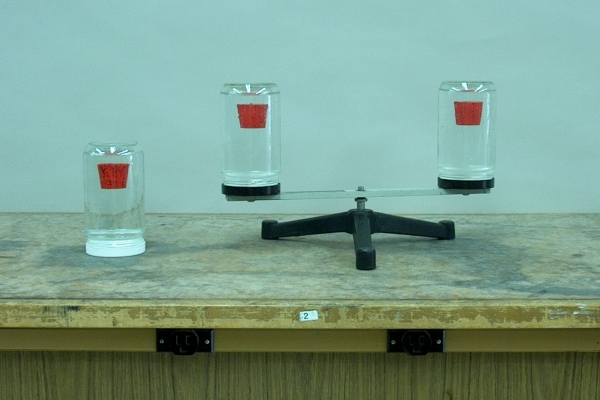
Red corks are attached by thread to the lids of inverted water-filled jars which, in turn, are attached to a rotatable metal bar. Start the jars revolving, and the corks lean towards the center of revolution.
As noted in the explanations for other demonstrations in this chapter, to cause a moving object to go in a circular path instead of a straight line, something must provide a force that is perpendicular to the direction of the object’s motion. When the object is moving in a circle, this force points inward along a radius of the circle, toward the center. It is thus called a centripetal force; “centripetal” means “center-seeking.” (The magnitude of this force is v2/r, or ω2r. (See demonstration 16.03 -- Ball on turntable.) This demonstration illustrates this force in a striking and perhaps counterintuitive way.
The inverted bottles with floating corks are a type of accelerometer. Before you start the apparatus rotating, it is a good idea to show the class how this particular accelerometer responds to an applied force. At left in the photograph above is a single inverted water-filled jar with floating cork, which is provided for this purpose. It is virtually impossible to accelerate for very long while walking, or otherwise to impart a linear acceleration on the jar. What you can do effectively, however, is, with the jar sitting on the demonstration table, to give it a sudden push. In this way, if you try really hard, you might be able to keep up the acceleration for short time, but the important thing is that upon the sudden impulse you give the jar, the cork moves in the direction of that impulse. A few quick shoves of the jar is enough to convince the class of this.
Once the class agrees that the apparatus responds by having the cork displaced in the direction of the applied force, you can have the students try to predict which way the corks in the revolving bottles will go. When you rotate the apparatus, as noted above, the corks move inward, towards the center of the circle in which they are moving. This may surprise some of the students.
These accelerometers are rather interesting. You might be able to explain their operation by noting that an external force applied to the jar causes the jar, in turn, to apply a similar force to the water inside, which generates a buoyant force on the cork, which is less dense than the water, in the direction of the applied force. A perhaps simpler and more elegant way might be to invoke Einstein’s equivalence principle (see demonstration 92.39 -- Vortx® wishing well), which states that an observer in a particular reference frame cannot tell the difference between his reference frame being accelerated in a particular direction, and gravity acting upon it from the opposite direction. Thus, accelerating the jar by giving it a shove is equivalent to the jar experiencing a gravitational force in the opposite direction. In such a situation, the water would tend to collect on the side of the jar where we gave the jar a shove, and the cork, which is less dense than the water, would float “on top” of the water, opposite the side of the jar where we applied the external force. Since the jars are also subject to the pull of earth’s gravity, they experience two accelerations at right angles to each other, which is why the air space is not displaced completely to the side of the jar. Gravity is constant, but we can vary the intensity of the push we give the single jar, or the speed with which we rotate the apparatus, and thus vary to some extent the deflection of the cork(s). (Since there is not much room for the corks to move, these accelerometers do not exhibit much range in their response, but in principle, if the jars were wide enough relative to the corks, their deflection would depend on the applied (lateral) acceleration.)